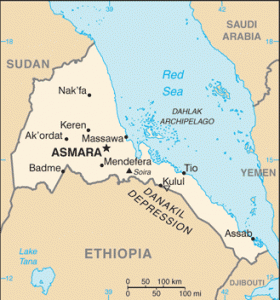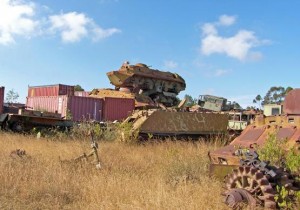I haven’t been posting over Christmas because I’ve been on holiday in Eritrea – so I think it appropriate to do a post based on a few observations of this little known country.
For A level students studying Global Development Eritrea, you can, for the sake of the exam, pigeon hole Eritrea as an example of a country that has failed to develop due to the isolationist policies of its paranoid left leaning government. Having said this, it would be more accurate to say that the case of Eritrea demonstrates how difficult it is to develop ‘general laws of development’ – Eritrea’s history is complex and it reminds us that understand development, or lack of it, requires looking at countries on a case by case basis.
An introduction to Eritrea
 On mentioning that I was going to Eritrea, no-one, it seemed, was able to locate it on a map, and some had never even heard of the place, so I guess a basic introduction is in order.
On mentioning that I was going to Eritrea, no-one, it seemed, was able to locate it on a map, and some had never even heard of the place, so I guess a basic introduction is in order.
Eritrea is relatively young African Nation on the horn of Africa, North of Ethiopia, east of Sudan and across the red sea from Yemen. If that doesn’t sound daunting enough, half a day’s drive through neighboring Djbouti would take you into Somalia, except that you wouldn’t be permitted to drive across that particular border, or any other land border for that matter, because they are all closed due to political tensions.
Eritrea is a god forsaken place, something Eritreans are actually begrudgingly proud of if you believe Michaela Wrong’s book ‘I didn’t do it for you: how the world used and abused a small African Nation’. The book is poorly written but is one of the best available for giving you an insight into the country and its history, which you have to understand in order to understand the country.
Focusing on more recent times – and being thoroughly Eurocentric at the same time – Wikipedia offers the following brief summary ‘The Italians created the colony of Eritrea in the 19th century around Asmara, and named it with its current name. After World War II Eritrea was annexed to Ethiopia. In 1991 the Eritrean People’s Liberation Front defeated the Ethiopian government. Eritrea officially celebrated its 1st anniversary of independence on May 24, 1992.’ Also of significance was a border war with Ethiopia, which lasted from 1998 to 2000 and lead to 100 000 deaths.

According to Michaela wrong, this history of conflict has helped to forge a kind of national identity founded on a stoic sense of independence and a coldness towards foreigners, given that the rest of the world stood by and did nothing to assist Eritrea in either its struggle for independence or in its later border war with its much larger neighbor. The signs of past conflict are noticeable – walking around Asmara you see the odd physically disabled war veteran, and if you travel further afield you come across abandoned military vehicles and bombed out buildings.
Some basic stats about Eritrea
Population – 5.7 million
GDP per capita – $700 – rank 224 in the world
Population below the poverty line – 50%
Infant Mortality Rate – 43/1000 live births – rank 65 in the world
Literacy rate – 59%
So what’s Eritrea like?
The only way into Eritrea for the aspiring tourist is by air – you have to fly into the capital city of Asmara, which at 7000 feet above sea level is the second highest capital in the world after La Paz, Given the arid, desert climate the air is very dry, and after a couple of days you will experience breathing difficulties, minor throat irritation, a general deterioration of skin quality, and a mild headache, which is only made worse when you encounter the bureaucracy surrounding travelling within the country.

Asmara is the only place a tourist can visit without an official permit. Travel to other destinations is strictly limited – and requires you to get a permit from the ministry of tourism specifying the exact dates of travel and the method of travel – including the car registration number if travelling in your own vehicle. Some parts of the country, in fact most of Eritrea, is out of bounds to tourists all together – namely those regions furthest from the Capital city near the politically sensitive outlying regions with the boarder countries.
Despite the travel restrictions, my ten day time limit, and the fact that I wasn’t exactly in explorer mode this holiday (well it was a holiday!) limiting my direct experience of Eritrea – this is of no real concern to my gaining an understanding of the country – direct experience is of little use to actually understanding a people who live under a repressive government run by a paranoid dictator – in such circumstances people tend to not open up out of fear.
Much of the information below comes from books, critical web sites and comments from people, who shall remain nameless, who have lived within the country for some years.
There are some nice things about Eritrea….

Firstly, it’s a good place if you like stylish cities boasting good architecture – most of the guide books rave about the architectural gems in Asmara – it’s an eclectic mix of styles reflecting different historical periods – add in.
Secondly, Asmara and surrounds are pretty chilled out, it’s safe, the roads are relatively quiet and there are relatively few beggars – even the children give up hassling you for money after a matter of seconds.
Thirdly, a legacy of the colonial past means that the city does an excellent line in Machiattos – which will set you back about 30 pence, at least if you get the favourable exchange rate.
Fourthly, Eritrea’s also a good place if you like dramatic dessert scenery – train or road from Asmara to Massawa provides for some dramatic landscape as you descend from 7000 ft to sea level.
There is more good stuff in Eritrea – namely the Dhalak Islands – which offer some of the best coral reefs in the world, but given that there’s only a handful of boats that go out there (yes you require a license from the government) I didn’t get out there.
And there are some not so nice things about Eritrea
Having said all of this, although Eritrea feels nice and safe and chilled, there is an undercurrent of repression running through the country –

The government is a dictatorship which maintains near absolute control over the media – there is one, state run newspaper – a propaganda rag that boasts about Eritrea’s development achievements, only two television channels, and no broad band internet; the government is also extremely suspicious of foreigners and restricts international trade through tightly controlling currency flows (you have to fill in a currency declaration form on arrival, and register any dollars that you change when in the country).
Then there’s the lack of freedom allowed to the citizens – If you are unlucky enough to be born Eritrean, you will be assigned a job based on your qualifications – and that will be your job for life – no opportunity to move up the career ladder; you wouldn’t be allowed to leave the country until you are over 50 if you’re a man (different rules apply to women), and even then most people won’t be able to afford to anyway; and men have to do two years compulsory military service, typically at some point in their 20s, longer if required by the state.
Finally there is the low level of material well being – Eritrea isn’t in famine, but there is a lack of variety of foods – there is a restricted supply of fruit and veg, and butter and milk are hard to come by. The food on offer in shops and restaurants is very uniform – fried eggs and foul mashed means and the local, fermented, bread appear to be the staples. There are no indicators of advanced economic development – shopping malls don’t exist, and consumer electronics – TVs, stereos, let alone computers, are extremely scarce – in fact when you enter the country you have to declare electronic goods and demonstrate that you still have them when you leave to prove you haven’t sold them on. The only new cars on display are those brought in by expats – diplomats and development workers – living in the country, local transport is decades old.
All in all the most depressing thing about Eritrea is that it is a place of such huge potential – the people seam stoical, there is mineral wealth, it is well located to be a hub of international trade, and yet the paranoid dictatorship seems to be holding it back, obsessed with idea that Eritrea needs to shun outside assistance from businesses and western governments, believing that these are responsible for the underdevelopment in other African countries, and that Eritrea needs to be self reliant.
Of course actually knowing how bad things are in this country is difficult – there is a dearth of reliable official information – so there will always be a level of uncertainty, but things have to be bad when several thousand people a year are prepared to risk imprisonment in order to escape to refugee camps in the Sudan.
And I never thought I’d hear myself say this – but I think that what Eritrea needs is a good dose of trade liberalisation! It’s all about balance at the end of the day.
To find out more about Eritrea – you can look up the stats on the CIA world fact book, browse through a brief history on Wiki and give Michaela Wrong’s book a go.
It’s definately worth a visit – it is a thoroughly odd place – and get there while you can – Eritrea might not be around as a country for too long – Ethopia must be gagging to get its hand on the port of Massawa (it’s lanlocked following Eritrean Independence) and I don’t believe there is that much popular support for the president.